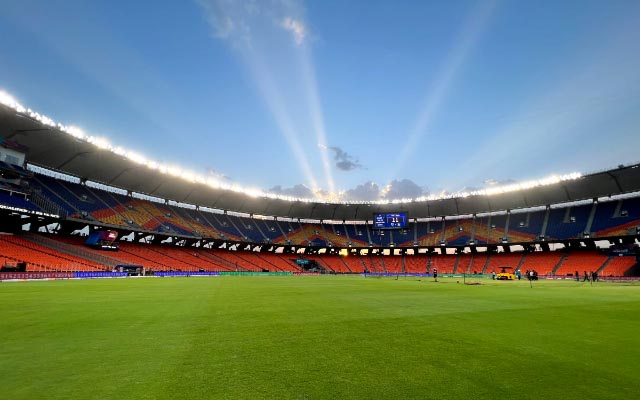Narendra Modi Stadium: Records, Stats, Venue Details, Capacity, Specifications, and Unique Features
Narendra Modi Stadium, Ahmedabad: History

The Narendra Modi Stadium in Ahmedabad, initially referred to as the Sardar Patel Stadium/Motera, was built in 1982. Situated near the banks of the Sabarmati River, the stadium underwent a massive change in 2015 when the Gujarat Cricket Association, under the then President of the GCA and Prime Minister of India Narendra Modi, decided to renovate and make it the largest stadium in the world.
In 2020, the reconstruction was completed with state-of-the-art facilities which included six indoor practice pitches and three outdoor practice fields, a seating capacity of 25 each in 76 corporate boxes, four team dressing rooms with associated facilities, and an indoor cricket academy with a dormitory for 40 athletes among others.
The stadium surpassed the record of Melbourne Cricket Ground which has an accommodation of 90,000 spectators. With over 1.3 lakh seating capacity, the Narendra Modi Stadium is currently the largest stadium in the world.
| Established | 1982 |
| Capacity | 1,32,000 |
| Floodlights | Yes |
| End names | Adani Pavilion End, Jio End |
| Home team | Gujarat, Gujarat Titans (GT, in IPL) |
| Curator | Bagira Thakur |
Narendra Modi Stadium Pitch Report
The 22-yard-strip at the Narendra Modi Stadium has an inclination for the batters. However, the deck also has something in it for the pacers to extract pace and bounce. Thus far, matches have been competitive and high-scoring in Ahmedabad.
Narendra Modi Stadium Records & Stats
In 2013, India great Sachin Tendulkar became the first cricketer to score 30,000 runs in international cricket as he achieved the feat at this venue. Former South Africa skipper AB de Villiers smashed a double-century (217*) against team India in 2008 and helped the Proteas win by an innings and 90 runs.
1983 World Cup-winning captain Kapil Dev claimed his 432nd wicket in Tests and breached Sir Richard Hadlee’s record to become the highest wicket-taker in the format in 1994. Against arch-rivals Pakistan, legendary cricketer Sunil Gavaskar went past the 10,000 run mark in Tests at this venue and became the highest run-scorer in the longest format in 1986-87.
Narendra Modi Stadium Stats in T20Is
| Total Matches | 7 |
| Matches won batting first | 4 |
| Matches won bowling first | 3 |
| Average 1st inns score | 183 |
| Average 2nd inns score | 152 |
| Highest total | 234/4 by IND vs NZ in 2023 |
| Lowest total | 66 by NZ vs IND in 2023 |
| Highest score chased | 166/3 by IND vs ENG in 2021 |
| Lowest score defended | 107/7 by WI-W vs IND-W in 2011 |
Narendra Modi Stadium Stats in ODIs
| Total Matches | 26 |
| Matches won batting first | 14 |
| Matches won bowling first | 12 |
| Average 1st inns score | 242 |
| Average 2nd inns score | 212 |
| Highest total | 365/2 by SA vs IND in 2010 |
| Lowest total | 85 by ZIM vs WI in 2006 |
| Highest total chased | 325/5 by IND vs WI 2002 |
| Lowest total defended | 193 by IND vs AUS in 1986 |
Narendra Modi Stadium Stats in Tests
| Total Matches | 15 |
| Matches won batting first | 4 |
| Matches won bowling first | 4 |
| Draw | 7 |
| Average 1st inns score | 347.53 |
| Average 2nd inns score | 353.06 |
| Average 3rd inns score | 232.06 |
| Average 4th inns score | 147.78 |
| Highest total | 760/7d by Sri Lanka vs India in 2009 |
| Lowest total | 76 by IND vs SA in 2008 |
Narendra Modi Stadium: Stands
The venue has 11 massive stands namely- Presidents Gallery, Adani Lower Pavilion, Adani Upper Pavilion, Club Pavilion, West Pavilion, GMDC Upper Pavilion, GMDC Lower Pavilion, North Stand (Lower), North Stand (Upper), East Stand (Lower), and East Stand (Upper). Furthermore, it has entry from all ends of the stadium.
Unique Features of Narendra Modi Stadium, Ahmedabad
| Corporate Boxes | 76 |
| Seating capacity of each Corporate Box | 25 |
| Entry Points to venue | 4 |
| Dormitory | 1 (for 40 athletes) |
| Indoor Practice Pitches | 6 |
| Outdoor Practice Fields | 3 |
| Dressing Rooms with Associated Facilities | 4 |
| Field Size | 180 Yards X 150 Yards |
| Stadium spread across 63 acres | |